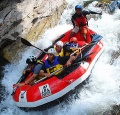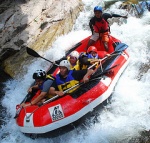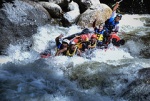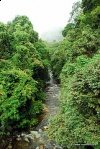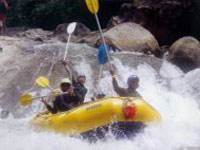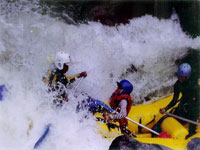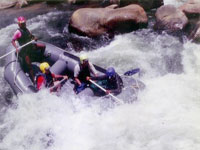Difference between revisions of "White water rafting in Malaysia"
| Line 1: | Line 1: | ||
| − | Rivers have long been the life blood of the indigenous people of Malaysia. They have served as a means of Transport, a source of food and now, a resource for eco-tourism. | + | Rivers have long been the life blood of the indigenous people of [[Malaysia]]. They have served as a means of Transport, a source of food and now, a resource for eco-tourism. |
<gallery perrow=4> | <gallery perrow=4> | ||
Revision as of 12:39, 28 April 2009
Rivers have long been the life blood of the indigenous people of Malaysia. They have served as a means of Transport, a source of food and now, a resource for eco-tourism.
- The must try white water rafting in Malaysia
seasons
- The dry season in Malaysia is a good season for rafting without havig to fight the currents. Smaller rafts are used in the dry season.
- During the raining season, its a good time to ride the rapids as the river swells and the current becomes more powerfull
IMPORTANT
- All participants will be required to sign a Liability Release before departure.
- Children below 12 years may participate with parents or legal guardians
- Participants must be physically fit.
- Jewellery & Contact lenses are not advisable.
What to bring to water rafting
- Change of clothes, Towel, Shoes, Slippers, Sunblock, Insect repellent, Personal toiletries, Waterproof camera (optional).
|
Pahang, Malaysia
|
|
Kedah, Malaysia
|
|
Selangor, Malaysia
|
|
Sabah, Malaysia
|
|
Perak, Malaysia
|
|
Johor, Malaysia
|
|
Kelantan, Malaysia
In the back country of Kelantan. Nenggiri river joins the Kelantan River at Kuala Krai. Sungai Nenggiri in Ulu Kelantan offers an exciting white water rafting in spectacular remote scenery. Some of Malaysia's richest archaeological caves are to be found along the river: Gua Cha, Gua Chawan and Gua Jaya. The only way to see the caves is by river, and because there are no roads leading to them, the caves have been left relatively undisturbed. The rapids are 'big water' and fairly easy to navigate.
|
International Grading Scale of River Difficulty
- Grade I - Moving water with a few waves and small ripples.
- Grade II Easy rapids with waves up to 1 meter and wide, clear, channels that are obvious without scouting. Some maneuvering is required.
- Grade III Rapids with high, irregular waves often capable of swamping an open canoe. Narrow passages that often require complex maneuvering.Rapids may require scouting from shore. Boaters in kayaks should have the ability to Eskimo Roll.
- Grade IV Long, difficult rapids with constricted passages and often turbulent waters. Scouting from shore is necessary, and conditions make rescue difficult. Generally not possible for open canoes. Boaters in kayaks should have the ability to Eskimo Roll.
- Grade V Extremely difficult, long and very violent rapids. Highly congested routes which always should be scouted from shore. Rescue conditions are difficult, and there is significant hazard to life in the event of a mishap. Ability to Eskimo roll is essential for boaters in kayaks.
- Grade VI Water is at the extremes of navigability. Nearly impossible and very dangerous. For teams of experts only. Close study must be made ahead of time and all precautions taken.

